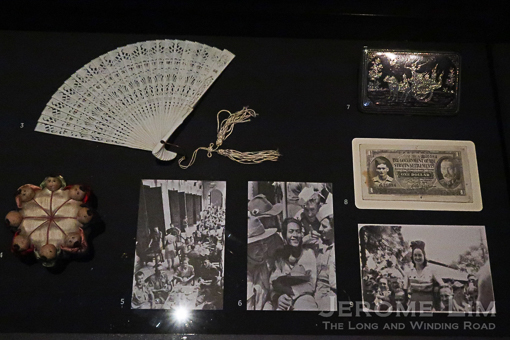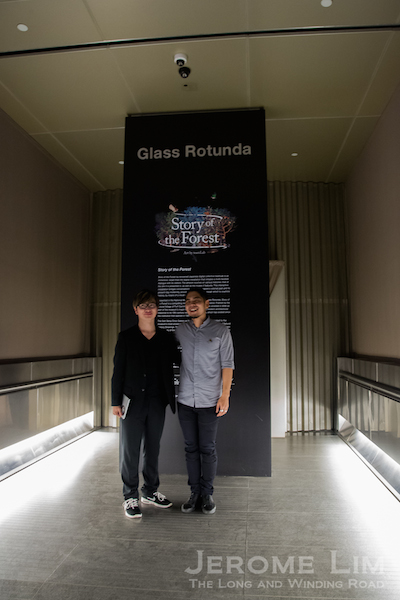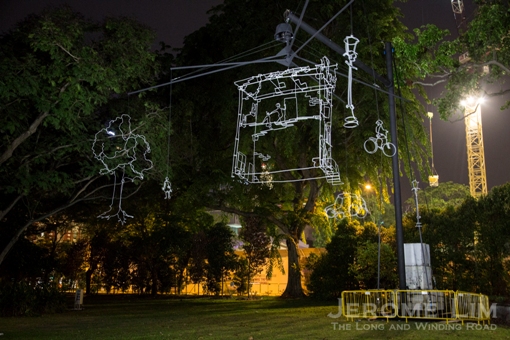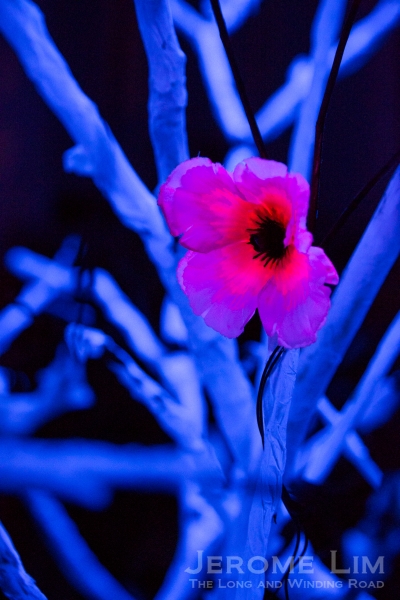It is from the treasure trove of what our ancestors have left behind that we find out much of what makes us who we are, the remarkable progress of the human race, and perhaps the common values that binds humans even the most diverse of cultures together. We have now an opportunity in Singapore to have a look at some very significant artefacts that have help to tell us the colourful and eventful story of humankind’s existence when the Treasures of the World from the British Museum exhibition opens on 5 December 2015. The exhibition, which will run for six months until 29 May 2016 , brings some of the best from the British Museum’s rather sizeable collection to the National Museum of Singapore.

Bust of Emperor Hadrian. From Tivoli, Italy. Around AD 125–130. Marble.
The British Museum’s repository of history provides us with a view that spans a period of more than two million years. For the exhibition, the oldest object being brought over is an 800,000 year old hand axe. The Quartzite axe, dates to the lower Palaeolithic period and originates from the Olduvai Gorge in Tanzania. Said to be the “Cradle of Mankind”, the gorge is where some of the earliest evidence of existence of our ancestors has been found.

Stone handaxe. Olduvai Gorge, Tanzania. Lower Palaeolithic, about 800,000 years old. Quartzite.
The exhibition has been laid out such that it spans out from the axe, much as humankind has spread out from the African continent. Objects are presented at a regional or continental level, providing a taste of the evolution of the diverse cultures in regions such as Africa, the Middle East, Asia, Europe, the Americas and Oceania.

The exhibition spans out from the 800,000 year old axe.
Among the exhibits, all of which have more than a story to tell, several caught my eye. There is the must-have mummy plus objects from the tomb from the museum’s well-known collection of Egyptian antiquities. The 2nd Century mummy, that of an adolescent boy, is particularly interesting for its “mummy portrait” – which shows the influence of the Greco-Roman tradition. The portrait – an Egyptian practice, is Roman in terms of style and technique. Such naturalistic portraits are thought to be among the finest surviving works of art from classical antiquity.

Mummy of an adolescent boy. Hawara, Egypt Roman period, AD 100–120
Human tissue, linen, gold, wax.
Among the funerary objects is 900 BC mummy board that gained the reputation of being an Unlucky Mummy. A series of misfortunes were attributed to the board – including a suggestion that it was onboard the ill fated SS Titanic when she sank on her maiden voyage.
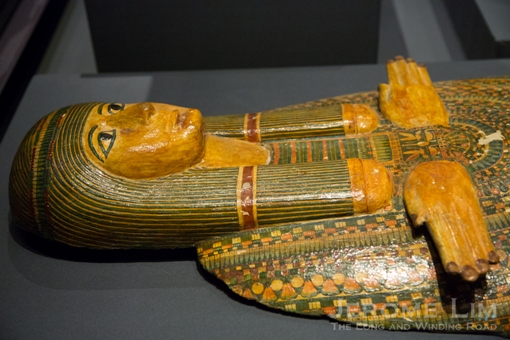
Mummy-board. Probably from Thebes, Egypt Late 21st or early 22nd Dynasty, 950–900 BC Wood, painted detail on plaster.
Another exhibit that is worth looking at is a memorial portrait bust of a priest from Palmyra – especially so with the recent destruction of the antiquities there. The limestone bust dates from AD 150 to 200 and is identified as that of Yedibel, the son of Oge Ya’ut. The hat identifies him as a priest.

A memorial portrait bust of a priest from Palmyra, Syria.
A set of objects from pre-Columbian America also provide a rare insight into the cultures of the period. One artefact that caught my attention is a deity mask representing Xipe Totec, a principal god of the Aztecs. The stone mask, interestingly, has a decorated inside surface carved with a four-armed figure – thought to represent a priest or the deity. Another interesting fact is that Xipe Totec means the “the flayed one”. This apparently alludes to the practice of wearing the flayed skin of sacrificial human victims during springtime planting festivals to ensure the renewal of life – the mask of dead skin was likened to dead vegetation concealing new life beneath it.

Deity mask. Mexico. Aztec (Mexica), around AD 1400–1521. Grey volcanic stone. (The reflection shows the carved inside surface).

Lintel showing a Maya ruler. Yaxchilán, Mexico. Maya, AD 600–900. Limestone.
Besides the Aztec mask, the funerary and memorial objects, many other representations of human forms and deities are noticeable throughout the exhibition. There are some of the tallest and heaviest exhibits that are found amongst these. One seemingly friendly chap is a 2.4 metre Welcome figure of the Kwakwaka’wakw people from Vancouver Island, who holds a hand out in welcome. Another tall object and striking form is one that was one half of a pair of door posts from a New Caledonian chief’s house.

Welcome figure. Vancouver Island, Canada. Kwakwaka’wakw people, 19th century AD. Wood.

Door post. New Caledonia. 19th or early 20th century AD. Wood.

The Oceania section.

A skull holder from New Guinea.
Two Young Explorers’ Zones, designed for children aged 7 to 12, will provide the younger ones with an excellent learning opportunity to. The zones feature activity sheets and learning stations. Also, in conjunction with the exhibition, public programmes such as workshops, curated tours, lectures by representatives from the British Museum and other historians, and theatre performances will be held. More information on this can be found at the National Museum of Singapore’s exhibition page. Admission charges apply.

An activity sheet for young explorers.

A young explorer zone (in the foreground).
Some other highlights:

Figure of a pregnant woman. Cyclades, Greece. Early Bronze Age, 2600–2400 BC. Marble.
During the third millennium BC, relatively prosperous and wellpopulated settlements flourished on the Cycladic islands in the central Aegean Sea. Among the most striking artistic creations of this period are schematic figures carved in marble. Most are female and are typically shown with their arms folded across the chest, the right arm always placed under the left. This well-carved example is notable for its swollen abdomen, which suggests pregnancy.
The significance of Cycladic figures has been the subject of considerable debate. Many come from graves, perhaps indicating that they were made particularly for funerary use. However, since numbers of them have also been found in settlements, they may have been important in the rituals of the living as well. The depiction of sexual characteristics, and occasionally pregnancy, points to an emphasis on female fertility.

Early erotica perhaps. Marble group of a nymph escaping from a satyr. Tivoli, Italy.
2nd century AD. Marble.
In ancient Greek myth, satyrs were part-human, part-animal beings closely associated with Dionysos, the god of wine. Given to wild passion, they are often shown in art as sexual predators chasing after nymphs and maenads, the female followers of Dionysos. In this marble group, a nymph struggles to free herself from a rapacious satyr who has locked his arms around her waist. Such images of amorous wrestling couples gave vivid expression to male erotic fantasies.

The sculpture is one of several known Roman versions of an earlier Greek work of the second or first century BC (now lost). With its complex composition of interacting bodies, designed to be seen in the round, it is typical of Hellenistic (later Greek period) art. The collector Charles Townley acquired the sculpture in 1773 through the English dealer Thomas Jenkins. It appears in the famous painting by Johan Zoffany, Charles Townley’s Library (1781–83), now in the collection of the Townley Hall Art Gallery and Museum, Burnley, England.

The Three Crosses. Rembrandt (Harmensz van Rijn) (Dutch, 1606-1668). AD 1653. Dry point etching.
The celebrated Dutch painter Rembrandt made over three hundred etchings, and the present work is one of his masterpieces. This scene of Christ’s crucifixion is extraordinarily dramatic on account of the bold contrast between light and shade, with the frail figure of Jesus spotlighted in the centre. The crowd of figures beneath the cross can just be made out in the gloom, an effect that heightens the sense of confusion and suffering that surrounds Christ’s death.
Rembrandt began training as an artist in Leiden at the age of 15. His skill and imagination led to great success once he moved to Amsterdam in 1631. Printmaking was a central element of his production. It supplemented his income and due to the portability of prints it also won him an international reputation, which was important to him since unlike many Dutch artists, he never travelled to Italy.
The Reformation emphasised the importance of private prayer, and prints such as this were both great works of art and a means of bringing Biblical stories vividly to life.

The heaviest treasure, approximately 1100kg. Grave Relief. Probably from Athens, Greece. 4th century BC; head re-cut in the early 1st century AD. Marble.
This grave relief depicts the idealised figure of a youth, naked but for a cloak over his left arm and shoulder. He holds a scraper or strigil, identifying him as an athlete. Although the stele and its image are of the 4th century BC, it was reused in the early 1st century AD to commemorate the death of a certain “Tryphon, son of Eutychos”. His name is inscribed on the architrave above the figure in Greek letters of the Roman period. To personalise the stele even further, the head was re-carved in contemporary Roman style. Once again, the “portrait” is idealised and may have borne no resemblance to the actual person it was intended to represent. This recycled artefact has survived in remarkably good condition.

Sir Thomas Stamford Raffles collection. General view of the temple at Borobudur. Around AD 1814. Watercolour on paper.
The temple complex at Borobudur in Central Java is undoubtedly one of the greatest Buddhist monuments in the world. It was built in the 8th and 9th centuries under the patronage of the kings of the Saliendra dynasty (ruled around AD 775−860) as a Buddhist pilgrimage site. Shaped like a stepped pyramid, the main temple is remarkable for its terraces that are richly decorated with relief carvings and Buddha figures. The site began to decline in the 10th century as royal power shifted away from Central Java to the east, and was eventually abandoned in the 16th century.
Borobudur was brought to the attention of European audiences by Thomas Stamford Raffles (1781−1826) during his time as British Lieutenant-Governor of the island. In 1814, when Raffles was informed about a huge “lost” monument deep in the jungles near Yogyakarta, he dispatched the Dutch engineer H. C. Cornelius to investigate. With a force of 200 workers at his disposal, it took Cornelius two months to clear the site and partially reveal the huge terraced pyramid seen in this drawing. It seems likely that the image was produced for Raffles around this time.

Earliest recorded batik and Sir Thomas Stamford Raffles collection. Batik cloth. Java, Indonesia. Before AD 1816. Cotton. In the foreground, Dagger and scabbard. Java, Indonesia Before AD 1816. Metal, silver, wood.
Indonesia and the island of Java particularly, is unrivalled for the scope and variety of its batik textile production. Although the technique of patterning cloth through the application of wax is known in other parts of the world, it reached the highest level of refinement and complexity on Java.
This sarong skirt cloth is one of two in the British Museum that are among the earliest known examples of Javanese batik in any collection. It consists of a central panel (kepala) made up of triangular motifs (tumpal) with vertical panels to either side, and a main body (badan) on which the broken knife (parang rusak) design has been drawn. Stylistic traits, particularly the parang rusak pattern that was restricted to royalty, mark it as a piece from the Central Javanese court of Yogyakarta.
As Lieutenant-Governor of Java, Stamford Raffles visited the Yogyakarta court on two occasions, in December 1814 and again in January 1816. It is probable that the British Museum batiks were presented as diplomatic gifts on one of these state visits.
———
A kris (or keris) is a type of dagger associated primarily with Indonesia and Malaysia, but also found in other areas of Southeast Asia. It is composed of three parts – the blade, the hilt and the scabbard – each of which may be decorated, with significance coming from the form and patterning. The blade is often, but not always, of a wavy shape. Worn by men, the kris was supposed to correspond with its owner’s physical proportions and temperament. As well as being weapons, kris are also heirlooms, part of ceremonial dress and a marker of social status. They are believed to have numerous magical properties, such as bringing good fortune or enhancing bravery. While a kris might bring back bad luck to one owner and have to be discarded, it could function benevolently with another individual.
This kris was collected by Sir Stamford Raffles during his posting as British Lieutenant-Governor of Java from 1811 to 1816.

Standing figure of the Buddha. Ancient Gandhara, Pakistan. AD 100–200. Grey schist.
Located in the region between modern northwest Pakistan and eastern Afghanistan, ancient Gandhara flourished as a major centre of Buddhism in the early centuries of the first millennium AD. Under the patronage of the ruling Kushan dynasty, numerous monasteries and shrines were constructed and furnished with narratives reliefs and devotional sculptures of the Buddha and bodhisattvas (Buddhas-to-be).
This serene figure, carved in grey schist, is representative of the classic Gandharan image. Draped in an elegant monastic robe, the Buddha assumes abhayamudra, the gesture of reassurance, offering protection to the worshipper with his raised hand (now lost). The halo surrounding the head signals his enlightened status. The sculptural traditions of Gandhara were greatly influenced by Greco-Roman prototypes, as is revealed here in the deeply cut folds of the robe and treatment of the hair.

(L) Painting of the bodhisattva Samantabhadra. Tang dynasty, around AD 750–850. Ink and colours on silk. (R) Painting of Lokapala Virūpākṣa, Guardian of the West. Tang dynasty, around AD 850–900. Ink and colours on silk.
The subject of this painting is the bodhisattva Samantabhadra, the special patron of the followers of the Lotus Sutra. He is shown seated on a lotus and riding a six-tusked white elephant, his familiar mount. During the Tang dynasty (AD 618–906) Samantabhadra was closely associated with Mañjuśrī, the bodhisattva of wisdom, and the painting may have been one of a pair of votive banners that were hung together for use in worship. Though the colours are today quite faded, in its original state the painting would have featured sumptuous highlights in blue, yellow, pink and red.
——–
This painting shows the lokapala Virūpākṣa, one of four heavenly kings who together protect the cardinal points of north, south east and west. He is depicted holding a sword, the jewelled scabbard of which rests directly on a demon’s head, only the sparse red hair of which remains. As with many such banners from Dunhuang, the image originally featured borders down each side and a band of lozenges at the bottom.

One of two brass plaques. Benin, Nigeria. Edo people, 16th century AD. Brass.
The powerful West African kingdom of Benin is famous for its brass castings, and particularly for its relief plaques which are unique in Africa. They were made from around 1550 to 1650 and were probably produced in matching pairs to clad the wooden pillars of the royal palace in Benin City. The palace was the centre of political and religious activities that ensured the well-being of the entire Edo state.
Some of the plaques portray important historical events while others depict scenes from court life and ritual. Both plaques illustrated here are dominated by the imposing figure of the Oba, or king, of Benin. On the left (a), the Oba is shown in the act of sacrificing a cow, assisted by five male priests who hold the animal’s legs and head still for him. He wears several items of royal regalia, including an elaborate headdress and necklace that signify his elevated social status and power. On the right hand plaque (b), the Oba is depicted with a spear in one hand and shield in the other. On his belt is a brass ornament in the form of a leopard’s head; the leopard being one of several creatures closely connected with royal power and authority. In the upper corners a pair of Portuguese traders are shown, each carrying a gift for the king. Depicted below are two attendants wearing pangolin (scaly anteater) skin helmets of the type associated with the leopard hunter’s guild.

Book of the Dead papyrus. Egypt. 21st Dynasty, 1069–945 BC. Ink on papyrus.
This sheet of papyrus comes from one of the longest illustrated manuscripts of the ancient Egyptian Book of the Dead to have survived. Originally over 37 metres long, it is now cut into 96 separate sheets. The Book of the Dead was a collection of spells, typically written on papyrus and placed in the tomb. These spells ensured that the deceased had access to the knowledge required to be successfully reborn into an eternal life. This sheet records part of spell 17, a long and complex discussion of the nature of the creatorgod. The illustration depicts the falcon headed sun-god Ra-Horakhty wearing a headdress composed of the solar disc.
The manuscript was made for a woman named Nestanebisheru, the daughter of the High Priest of Amun Pinedjem II. In this particular illustration, she is seen kneeling in front of Ra-Horakhty, raising her hands in adoration. She is accompanied by her spirit (ba) in the form of a bird with a human head.

(L) Second heaviest treasure. A divine attendant Nimrud, northern Iraq. Neo-Assyrian, 810–800 BC. Limestone. (R) Relief showing a protective spirit. North-West Palace, Nimrud, northern Iraq. Neo-Assyrian, around 875–860 BC. Gypsum.
This is one of a pair of guardian deity figures that stand in an attitude of attendance. The figures originally flanked a doorway in the temple of Nabu, an important god of writing, in the Assyrian capital of Kalhu (modern Nimrud). The cuneiform inscription carved around the guardian’s body states that they were dedicated to Nabu by the local governor, on his own behalf and on behalf of king Adadnirari (ruled 811–783 BC) and the queen mother Sammuramat. The inscription ends with the request that the reader should trust Nabu above all others.
The statues were discovered at Nimrud in 1854 by Hormuzd Rassam, who was excavating the site on behalf of the British Museum. According to his account, there was another pair of statues without inscriptions carrying basins, but these were subsequently lost or destroyed.
——–
This relief from a royal palace shows an Assyrian protective spirit. The winged eagle-headed spirit, originally one of a pair that reached out and touched the “sacred tree”, carries a tree cone or “purifier” that was probably covered in liquid from the bucket. The sacred tree, partly preserved on the left, possibly represents the fertility of the land.
The decoration of Assyrian palaces with extensive stone bas-reliefs was an innovation from the West first found in the palace of king Ashurnasirpal II (ruled 883−859 BC) at Nimrud. While some of the decoration in this palace, particularly in the throne room, was narrative and depicted events, the majority of reliefs depict protective spirits that were designed to ensure the well-being and prosperity of the palace’s inhabitants and Ashurnasirpal’s kingdom.

Ivory figure of St. Joseph. Hispano Philippine. 17th Century AD. Ivory, gilded.
This carved ivory figure of St. Joseph, the foster father of Jesus, was produced in a workshop in Manila. Many fine ivory figures of Christian saints like this were produced in the 17th and 18th centuries, when the Philippines was under Spanish control. They were intended for churches, monasteries and wealthy homes in the Americas and Spain.

Ru dish with emperor’s inscription. Qingliangsi, Henan province, China. AD 1086-1125. Stoneware with celadon glaze.
Ru is the rarest of all the major Chinese ceramic wares. It is greatly admired for its elegant forms and duck egg blue glaze. The pink blushes on the glaze of this dish may have been caused by the great fire at the Chinese imperial palace in Beijing in 1923. On the base is an inscription by the Qianhong emperor (ruled AD 1736-1795), which comments on the quality of the vessel.

























































